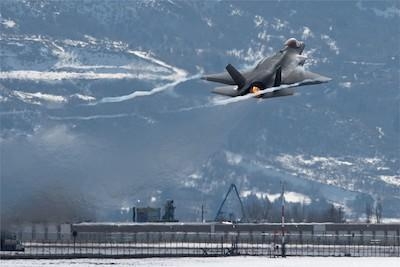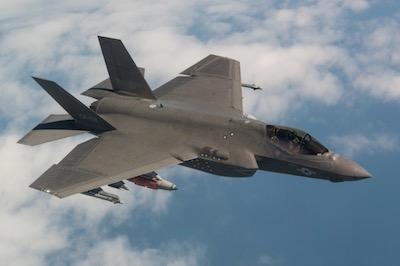Fri, Nov 25, 2022
The Lightning Program is Doin' Just Great, As Per Usual
A 2020 flight restriction on the F-35A will reportedly not be rescinded any time soon, preventing the Lightning fighter from operating within 25 miles of lightning storms.

The issue stems from a problem with damaged tubing inside the keystone of the fighter's lightning protection system. The Onboard Inert Gas Generation System (OBIGGS) was expected to be fixed some time last summer according to the F-35 Joint Program Office, but now a finalized solution to the problem isn't ready in the foreseeable future. The JPO has assessed the hardware and software upgrades, but according to Chief Petty Officer Matthew Olay, the restrictions will remain in place.
“Due to additional findings earlier this year, this upgrade will provide an improvement, but is insufficient to lift the lightning restriction,” Olay told reporters. “Lightning restrictions will be lifted when all safety concerns are resolved or acceptably mitigated.”
His office remains understandably mum about the fighter's continuing issues, given its position as the poster child of advanced American fighter tech. Olay said that things are still up in the air, only stating that the “JPO continues to take steps to address all lightning restriction concerns through all available means." The F-35A will remain hobbled as-is until "all safety concerns are resolved or acceptably mitigated”, whenever that may be.

OBIGGS has long been a sticking point for the program, causing issues for nearly a decade now. The system is designed to provide nitrogenous air into the F-35's fuel tanks when lightning is present, purging oxygen from the system to lower the probability of combustion should a lightning strike occur. The unsurprisingly advanced (maybe even a little convoluted) solution was the cause of flight restrictions and redesigns in 2014, but evaluation of lightning-stricken aircraft revealed weaknesses in OBIGGS. From there, the usual routine began, with inspections for proper installation followed by revisions to the design itself. New, hardier hardware was rolled out in November 2021, with accompanying software released last August. Rollout of the fix will likely take some time, given USAF's 375-strong F-35A fleet. Until further notice, the Lightning II will have to keep its distance from its namesake.
More News
Aero Linx: International Federation of Airworthiness (IFA) We aim to be the most internationally respected independent authority on the subject of Airworthiness. IFA uniquely combi>[...]
Ultrahigh Frequency (UHF) The frequency band between 300 and 3,000 MHz. The bank of radio frequencies used for military air/ground voice communications. In some instances this may >[...]
A Few Questions AND Answers To Help You Get MORE Out of ANN! 1) I forgot my password. How do I find it? 1) Easy... click here and give us your e-mail address--we'll send it to you >[...]
From 2019 (YouTube Edition): Learning To Paint Without Getting Any On Your Hands PPG's Aerospace Coatings Academy is a tool designed to teach everything one needs to know about all>[...]
Also: Sustainable Aircraft Test Put Aside, More Falcon 9 Ops, Wyoming ANG Rescue, Oreo Cookie Into Orbit Joby Aviation has reason to celebrate, recently completing its first full t>[...]
 ANN's Daily Aero-Linx (05.06.25)
ANN's Daily Aero-Linx (05.06.25) ANN's Daily Aero-Term (05.06.25): Ultrahigh Frequency (UHF)
ANN's Daily Aero-Term (05.06.25): Ultrahigh Frequency (UHF) ANN FAQ: Q&A 101
ANN FAQ: Q&A 101 Classic Aero-TV: Virtual Reality Painting--PPG Leverages Technology for Training
Classic Aero-TV: Virtual Reality Painting--PPG Leverages Technology for Training Airborne 05.02.25: Joby Crewed Milestone, Diamond Club, Canadian Pilot Insurance
Airborne 05.02.25: Joby Crewed Milestone, Diamond Club, Canadian Pilot Insurance




